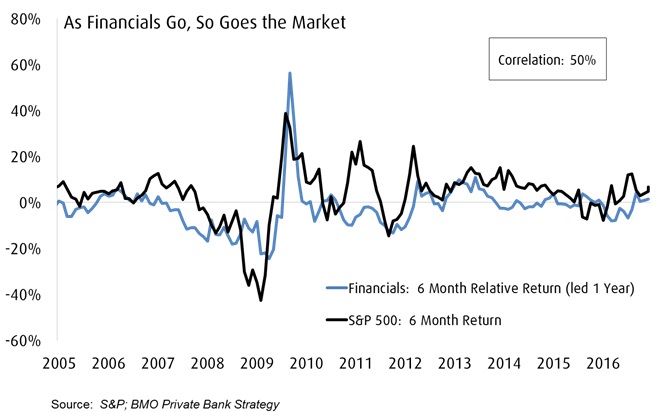The stock market’s dramatic surge to record highs can largely be attributed to the leap in bank stocks.
Without the sector, the S&P 500 would not have closed at a record Thursday, but would still be only 0.25 percent below the old record it hit Aug. 15, according to Howard Silverblatt of S&P Dow Jones Indices. Meanwhile, his data shows that Goldman Sachs has accounted for nearly a third of the Dow Jones industrial average’s gains since the election.
There’s been a “total turnaround in the financials, and a lot of it is perception about what could be done” under President-elect Donald Trump, Silverblatt said.
 Source: CNBC analysis using FactSet
Source: CNBC analysis using FactSet
After starting the year as the worst performer in the S&P 500, banks have been the best sector since Election Day on Nov. 8, rallying more than 18 percent to hit their highest level since December 2007 as of Thursday. The S&P 500 has climbed nearly 5 percent since the election, also to all-time highs.
In contrast, financial stocks — which included real estate until those stocks’ separation into a new sector in September — declined by 0.47 percent over the period between the end of 2014 and Election Day 2016. The broader S&P 500 took more than a year from May 2015 to post a new high this past July.
“It’s very difficult to get a sustained rally without the financials rallying,” said Jack Ablin, chief investment officer at BMO Private Bank.
He found that the S&P 500 tends to follow the performance of the financials sector, which has the second-greatest weighting in the index.

Banks are “really advancing on the back of higher interest rates. It’s probably the one sector that benefits from higher rates. I think investors are not only gravitating to it, but they are using it as a hedge,” Ablin said. Higher interest rates increase banks’ profit margins.
The financial sector is watched as an indicator of economic growth. The more business activity there is, the more loans are taken out, and the more money banks can make.
“It’s typically healthy that the financials are leading. It’s suggesting the economy is in good shape. It’s not something we’ve had” over the last few years, said Bruce Bittles, chief investment strategist at Baird.
Financials were already on the rise ahead of the U.S. presidential election, as the economic outlook improved, as trading volumes picked up and as global central bank policy appeared to turn less stimulative.
Since the election, Treasury yields have jumped on expectations of economic growth stemming from Trump’s promised tax cuts and infrastructure spending. The incoming administration is also expected to roll back some of the regulations imposed on banks after the financial crisis.
“What we ultimately get is stimulus and regulatory rollback,” said Tom Wright, director of equities at JMP Securities. He said those policies should have a much bigger effect than would a 25 basis point rate hike (0.25 percentage point) from the U.S. Federal Reserve.
“Generally, investors have been underweight (banks) for a long time, in the broader brush of things, since the financial crisis in ’09,” he said. “This is a major shift, and there are larger pools of money that are going into financials.”
For example, in the week after the election, RBC Capital Markets began recommending financial stocks as the firm revised its views on seven S&P 500 sectors.
Bespoke Investment Group predicted in a Thursday note that the sector still has room to run higher.
“Financials dropped more than 80 percent during the financial crisis, while the energy sector fell 40 percent from mid-2014 through January of this year,” the note said. “So while sectors like consumer discretionary and industrials have also rallied sharply higher since the election, they have exploded higher into new all-time high territory. Financials and energy, on the other hand, both still need to gain roughly 30 percent to get back to their prior all-time highs.”
Meanwhile, the rally has spread. Not only have the S&P 500, Dow Jones industrial average and Nasdaq composite hit records, but so have the small-cap Russell 2000 index and the Dow transports. The transports posted their first new high in two years on Wednesday, and all six major indexes hit fresh highs Thursday.
“From a technical standpoint, the situation has improved, even though valuations are stretched,” said Ablin, who played down the concerns of investors “equaling this to a tech bubble of the late ’90s.”
“Now it’s just a matter of waiting for the fundamentals to catch up with what the expectations are,” he said
source”cnbc





